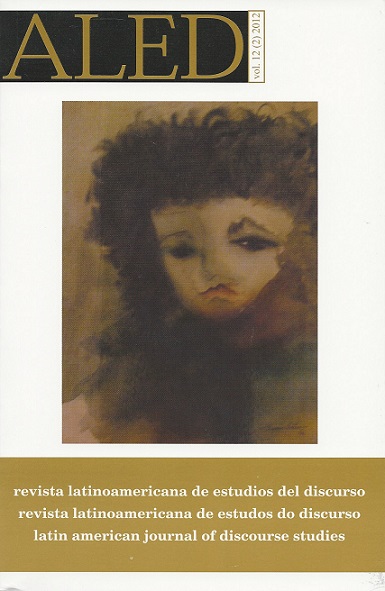Indígenas en la prensa mexicana en el contexto preelectoral de fines del foxismo
Keywords:
journalistic discourse. political discourse. indigenous population. racism. discrimination. exclusion.Abstract
This paper presents the results of a quantitative and qualitative analysis of 189 news articles related to the indigenous population and published in fifteen Mexican newspapers during June and July 2005. The original aim was to identify traces of exclusion and discrimination against the indigenous population in the press, considering that journalistic discourse is a discourse of power capable of playing an important role in the reproduction of racist stereotypes. During the analysis, another element was clearly revealed: amidst a context marked by increasing political turmoil (which would eventually end in the presidential election in July 2006), the indigenous population of Mexico, their demands, their claims, their needs, were incorporated into the public agenda to create a favorable image of the political actors involved in the struggle to obtain the presidency.
Downloads
References
ARMENTIA VIZUETE, J. I. y CAMINOS, J. M. (2003). Fundamentos de periodismo impreso. Barcelona: Ariel.
AUSTIN, J. (1971 [1962]). Cómo hacer cosas con palabras. Barcelona: Paidós.
BENAVIDES DELGADO, J. (1997). Lenguaje publicitario. Madrid: Síntesis.
BÖCKELMANN, F. (1983). Formación y funciones sociales de la opinión pública. Barcelona: Gustavo Gili.
BOURDIEU, P. (1984). Cuestiones de sociología. Madrid: Ediciones Istmo.
CARBÓ, T. y SALGADO ANDRADE, E. (2006). ‘Invisibilidad de las lenguas indígenas en la prensa nacional mexicana, o: el recuento de un ¿olvido? (1989-1995)’, en R. Terborg y L. García Landa (coords.), Los retos de la planificación del lenguaje en el siglo XXI, pp. 525-562. México: Centro de Enseñanza de Lenguas Extranjeras.
CHILTON, P. A. y SCHAFFNER, C. (2000). ‘Discurso y política’, en T. A. Van Dijk (comp.), El discurso como interacción social. Estudios sobre el discurso II. Una introducción multidisciplinaria, pp. 297-329. Barcelona: Gedisa Editorial.
CHILTON, P. A. y SCHAFFNER, C. (eds). (2002). Politics as talk and text: Analytic approaches to political discourse. Filadelfia, USA: John Benjamins.
FAIRCLOUGH, N. Y WODAK, R. (2000). ‘Análisis crítico del discurso’, en Teun A. van Dijk (comp.), El discurso como interacción social. estudios sobre el discurso. II. Una introducción multidisciplinaria, pp. 367-404. Barcelona: Gedisa.
FONTE, I. (2008). ‘Un estudio pragmático del conflicto político mexicano-cubano (2004) en la prensa’. Discurso y Sociedad, 2 (1): 87-115. (Disponible en www.dissoc.org).
GEE, J. P. (2005). An introduction to discourse analysis. Theory and method. Londres: Routledge. hodge, R. y Kress, G. (1988). Social semiotics. Londres: Polity Press.
MERINO, M. E. (2007). ‘El discurso de la discriminación percibida en Mapuches de Chile’. Discurso & Sociedad, 1(4): 604-622.
MERINO, M. E. y TILEAGA, C. (2011). ‘La construcción de identidad de minorías étnicas: un enfoque discursivo psicológico a la autodefinición étnica en acción’. Discurso & Sociedad, 5(3): 569-594.
MERINO, M. E., QUILAQUEO, D. y SAIZ, J. L. (2008). ‘Una tipología del discurso de discriminación percibida en mapuches de Chile’. Revista Signos, 41 (67): 279-297.
PINO, A. P. y MERINO, M. E. (2009). ‘Discriminación e identidad étnica en el discurso oral de adolescentes mapuches en contexto escolar de la ciudad de Temuco’, Discurso y Sociedad, 4 (1): 103-119.
SALGADO ANDRADE, E. (2009). ¿Qué dicen los periódicos?Reflexiones y propuestas para el análisis de la prensa escrita. México: CIESAS.
VAN DIJK, T. A. (1997). Racismo y análisis crítico de los medios. Barcelona: Paidós.
VAN LEEUWEN, T. (1993). ‘Genre and field in critical discourse analysis. Discourse and Society, 4: 193-223.
WODAK, R., DECILIA, R., REISIGL, M. y LIEBHART, K. (2000). The discursive con-struction of national identity. Edimburgo:Edinburgh University Press.
Downloads
Published
How to Cite
Issue
Section
License

This work is licensed under a Creative Commons Attribution-NonCommercial-NoDerivatives 4.0 International License.
The authors retain the copyright and guarantee RALED the right to be the first publication of the work as well as a Creative Commons Attribution License that allows others to share the work with recognition of authorship and the initial publication in this journal.




